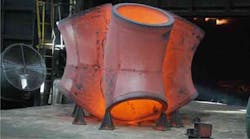Bradken Limited, the mining and railroad products conglomerate, received a non-binding takeover bid from two private-equity funds, one that values the group at A$872 million ($730 million.) The A$5.10/share proposal by Pacific Equity Partners Pty. Limited and Bain Capital Asia LLC is lower than a confidential, exploratory offer that the two groups made in August, after which no firm proposal was made.
Late last week, Bradken’s board noted the current proposal represents “a significant premium” to the company’s Friday closing price per share.
“The board notes that the proposal by the consortium has been made at a low point in the mining cycle during a time of significant share price volatility in the broader mining services sector,” Bradken stated. “In this context, the board has determined that it is important for shareholders to be aware of the proposal.”
Bradken operates numerous steel foundries, machine shops, and fabricating operations in Australia, Canada, China, Great Britain, and the U.S. Its North American steel foundries, each with dedicated machine shops, include: Bradken-Amite in Amite, LA; Bradken-Atchison/St. Joe, in Atchison, KS; Bradken-Atlas, Tacoma, WA; and Bradken-London, London, ON.
Together with the disclosure of the takeover bid, Bradken announced it has acquired a ferrous foundry in India’s Tamil Nadu state, for A$27 million ($22.5 million.) The 17,000-sq.m. operation has a capacity over 20,000 metric tons/year. “It will provide low-cost manufacturing capacity in a location that has proximity to key customer markets in Australasia and Africa, as well as a large domestic market in India,” Bradken stated. Initially, it plans to operate the new foundry as low-cost site for producing mill liners, coal, and cement wear parts, and large structural castings for Asian markets.
Also, Bradken outlined a A$26 million ($21.6 million) in capital investments it described as “fast-payback” designed to increase EBITDA on existing businesses. Among these would be installing robotic grinding at the Mont-Joli, Quebec, foundry (a former Norcast Wear Solutions plant); automating welding operations and installing new core-handling and riser knock-off equipment at U.S. foundries; and installing casting handling and robotic grinding equipment at the Wodonga foundry in Australia.
The company also would transfer clad-plate manufacturing to Xuzhou in China, as part of the same investment program.
The Indian foundry acquisition and capital investments are expected to be completed by mid 2016.
Bradken stated the board had approved a “small” effort to raise equity by issuing stock, but it has tabled that effort in view of the takeover proposal.









